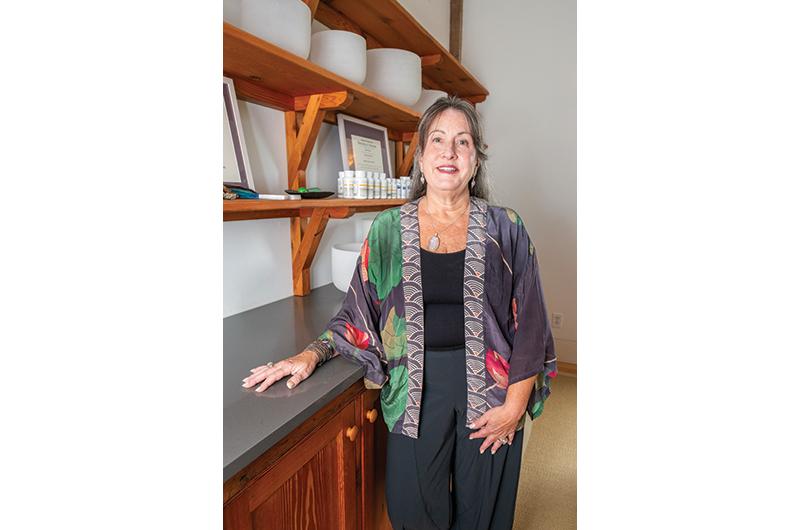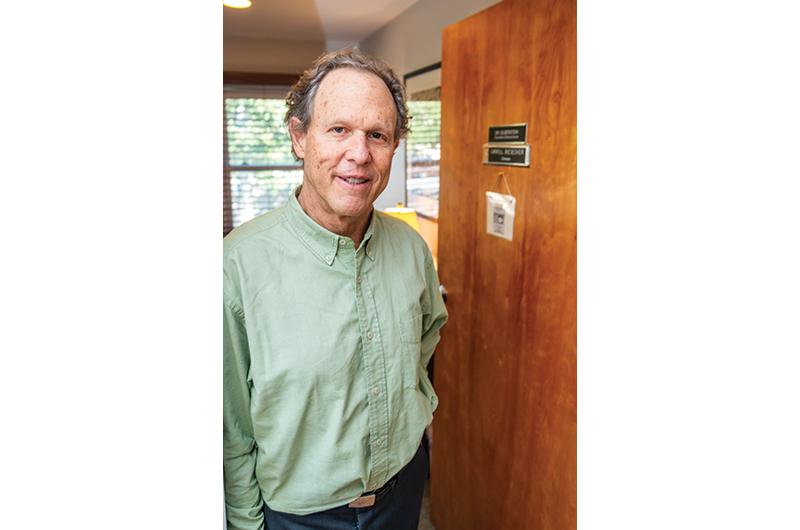Mark was on his last nerve. He had been in and out of therapy for the better part of thirty years and tried surgery, acupuncture, chiropractic, as well as various meditation and affirmation techniques to relieve his chronic pain. For a time, he even thought he was cured, until a few months ago his sciatica – a shooting, acute pain that was once in his neck and was now running through his left leg – returned. He had long known that his pain did not reflect any physical problem. He knew it was all in his head.
“I’d had similar things before, and I had dealt with them by dealing with what was bothering me,” he said. “This just wouldn’t go away.”
The debilitating pain in his leg prevented him from taking part in any of the sports or activities he usually enjoyed. He continued to suspect that his chronic pain stemmed from mental distress, but as far as he could tell, everything in his life was fine.
On a whim, he asked a friend, a chiropractor on-Island, if they knew anyone who practiced psychedelic therapy.
“I was desperate,” he said. “I was looking for anything that would help.”
This past summer, Mark ended up in Prudy Carter-Donovan’s office, a small room located in the Yoga Barn in West Tisbury. Since 2021, Carter-Donovan, a nurse practitioner, has offered ketamine therapy services to Islanders and vacationers who, like Mark, felt they had exhausted every other option.
Her practice reflects larger shifting norms around psychedelic therapy, which reached a zenith in the 1950s with the advent of lysergic acid diethylamide (LSD), only to be all but shut down when LSD was classified as a Schedule I substance in 1968. In the past few decades or so, relaxing attitudes toward psychedelics have caused the science to move from the fringes toward the mainstream, this time with ketamine, a psychedelic-like medication, playing a central role.
Combined with other forms of therapy, ketamine has changed Mark’s life, he said. After just one session, he noticed a reduction of pain. Three more sessions later, his pain had abated substantially, and his mood has dramatically improved. Out of respect for patients’ privacy, the magazine has agreed to keep his and others’ experiences anonymous.
“I’m not in physical pain anymore,” he said. “But I also just feel lighter, and freer, and less – I’m not sure how to describe it exactly – I just feel better.”
Ketamine, also known as “ket” or “Special K,” has been FDA-approved as an anesthetic since 1970. For decades, it was commonly used to treat pain in children, but physicians had also observed it to induce a dissociative-like high in some patients. That high granted ketamine niche popularity in club scenes, in which users describe taking too much ketamine as “falling into a K-hole.”
However, ketamine’s dissociative properties and relative ubiquity as a generic drug has also made it an ideal candidate for practitioners interested in psychedelic therapy. While ketamine is not FDA-approved as a therapeutic drug, physicians and practitioners have the license to use it “off-label” in therapeutic settings – which is to say that, although ketamine therapy is legal, it does not have the same federal oversight as other more conventional treatments.
Because ketamine therapy is still a relatively new practice, it is often recommended for severe, “unremitting” depression after traditional methods – such as talk therapy and antidepressants – fail. While antidepressants are designed to be taken daily, ketamine is administered through a series of periodic injections, and it can be up to the patient to decide when to return for another round. Chemically speaking, psychedelics also have a very different effect on the brain.
Dr. Charles Silberstein is a psychiatrist at Martha’s Vineyard Hospital and the medical director of the Island Counseling Center, a division of Martha’s Vineyard Community Services. He has worked with Carter-Donovan for years providing mental health services, and is one of several Island medical professionals who have referred patients to Carter-Donovan’s practice.
The basis of psychedelic therapy, he said, lies in psychedelics’ ability to induce what’s called “neuroplasticity,” a state in which the brain is more malleable, less inhibited, and more open to new ideas and ways of thinking.

“There are connections made in the mind that are not normally available,” he said.
Until recently, research into the therapeutic potential of psychedelics such as ketamine had been dormant. The breakthroughs in psychedelic research that had occurred in the 1950s and ’60s had been pushed to the fringes. Research was further stifled in 1970, when the Nixon administration signed the Controlled Substances Act.
And yet slowly, psychedelic research began to experience a revival in the early 1990s, led by scientists in the U.S., Switzerland, and Germany. The majority of the studies published in that early period dealt with psilocybin, also known as “shrooms” or “magic mushrooms,” and their effectiveness in treating anxiety, obsessive-compulsive disorder, alcoholism, and even depression related to terminal cancer. Each clinical trial showed significant improvements in the patients involved.
In 2006, interest in ketamine’s therapeutic potential increased when the National Institute of Mental Health found that a small injection of the drug could improve symptoms of depression. Since then, the industry has only expanded. Once confined to private clinics, mental health treatment facilities as large as Mass General Brigham’s McLean Hospital have now started to offer ketamine treatment. As of February 2023, there were an estimated 500 to 750 ketamine clinics nationwide, prompting some health experts to push for a national registry of clinics and greater oversight of the science.
The research related to the field so far is limited but promising. In September 2022, the Journal of Clinical Psychiatry published a three-and-a-half-year study of more than 400 patients at three ketamine clinics in Virginia. It found a significant reduction in symptoms of depression, with 72 percent of patients noticing improvements in their mood and 38 percent reporting being symptom-free after ten infusions.
Carter-Donovan began to explore the use of ketamine as a form of therapy after becoming disillusioned with the type of treatment she was able to administer in her previous roles. The Island has long dealt with a shortage of mental health professionals, she explained, and the patients she would see at the Martha’s Vineyard Hospital and Island Health Care, an Edgartown clinic, would often deal with long delays and wait lists before receiving care.
“As a primary care provider, I was often the first person who would see a patient that had concerns about depression or anxiety,” Carter-Donovan said. “In the absence of options for connection…people needed immediate help.”
Five years ago, she was inspired by Vineyard summer resident Michael Pollan’s book How to Change Your Mind (Penguin Press, 2018) to travel to Central America to meet with traditional healers. Her experience there prompted her to look for a more holistic way to improve mental health. “It really allowed me to understand that for a lot of mental health concerns, having the courage to make changes in your life, changes that would address the issues that are contributing to your mood, makes a lot more sense for a lot of people,” she said.
“A lot of the times when we’re having depression or anxiety, it’s really our own kind of inner wisdom letting us know that something’s out of balance in our life. And treating that kind of distress with medicine probably doesn’t address the root cause of the problem.”
Carter-Donovan returned home and immediately looked for ways to incorporate what she had learned into her practice. Working with what was available, she began collaborating with psychiatrist Silberstein to administer ketamine infusions on-Island. While ketamine is not technically a psychedelic, its effects on the brain are very similar, she said. “With chronic symptoms, often the neurotransmission is dampened. The brain literally gets in a rut, is how I describe it, and ketamine allows the brain to get out of it.”
In 2021, nurse practitioners in Massachusetts were granted the ability to run their own private practices – a privilege previously only available to physicians. She found a space in the Yoga Barn to set up Inner Journey Wellness and began offering ketamine and other therapeutic services the same year. She’s since performed hundreds of ketamine treatments.
“I wanted to work at the intersection of medicine and spirituality…and that didn’t exist,” she said. “So I needed to create that practice.”
Ketamine treatment may vary from clinic to clinic, but it usually involves repeated sessions in which a patient receives a low dosage of the drug relative to the patient’s weight over the course of several weeks. Carter-Donovan’s treatment involves six sessions spread out over two or three weeks. After a ketamine session, patients are often instructed to organize a ride home and rest, but within a couple of hours most patients can resume life as normal, she said.
While most ketamine treatment centers simply administer the round of doses, Carter-Donovan’s is one of a minority of clinics combining ketamine therapy with what’s called Internal Family Systems (IFS) therapy. It is, in her mind, as integral to her practice as the ketamine itself. “I think it’s at least 50 percent responsible for the benefit of the ketamine work,” she said.
IFS therapy was developed by psychotherapist Richard Schwartz in the 1980s and deals with the mind as a system of parts, rather than one whole. Under IFS therapy, conflicting emotions can be characterized as individuals, each with their individual needs. Understanding and meeting those needs, Schwartz posits, is the key to unraveling inner conflict.

“The first session I did was, I thought, the most impactful therapy session I’ve ever done by far,” Mark said of his experience with IFS. “It was as valuable as thirty years of regular [therapy].”
One patient, Pauline Freedman, began IFS therapy and ketamine treatment with Carter-Donovan in the fall of 2022. Like Mark, she had tried decades of therapy to treat what she thought had been persistent chronic depression. About five years ago, she learned she instead had a form of complex PTSD.
Complex PTSD, or CPTSD, is a form of post-traumatic stress disorder caused by recurring or long-term traumatic events. Those who experienced childhood abuse, sexual abuse, domestic violence, or other traumatic situations are often diagnosed with CPTSD, which can manifest as feelings of worthlessness, trouble connecting with other people, or difficulty controlling emotions, among other things.
“It just made sense,” she said of her diagnosis. “For the first time, things started to make sense.”
Freedman attended two IFS therapy sessions with Carter-Donovan before beginning her ketamine doses. Through IFS, Freedman said she has been able to determine the root cause of some of her deeper anxieties, from her fear of flying to a compulsive need to plan for the worst. By the time she started receiving ketamine injections, the medication had what she described as a “jump-starting” effect.
“If IFS therapy is like digging a hole with a teaspoon, IFS with ketamine is like digging with a backhoe and a stick of dynamite,” she said.
Coupled with IFS therapy beforehand, the effects of ketamine can be very powerful.
“I felt like I was in touch with the infinite,” Mark said. “And I’m not really a sucker for New Age stuff, but I do yoga, I meditate, I read the Dr. Bronner’s soap bottles…so I believe generally in that kind of thing.
“There was one session in particular where I felt this incredible sense of safety,” he continued. “I don’t know how to describe it exactly except that life and death felt like part and parcel of the same thing, and it always came back to, ‘I want to be back in my body, I want to go do stuff, I want to live my life.’ I never wanted to live in that space…but I really liked going there.”
The patient never undergoes therapy during or directly after ketamine treatment, but the first hour of the following session is always devoted to what Carter-Donovan calls “integration.” During integration, patients have a chance to discuss their ketamine experience from last session and process any feelings through an IFS lens.
To take advantage of the high neuroplasticity patients experience post-treatment, Carter-Donovan encourages her patients to pursue creative passions and interests between sessions. Some patients have also kept journals to chronicle their progress.
For Freedman, the connections she made in IFS therapy seemed to stick better after the ketamine treatment, and the mild euphoria she experienced from the drug reminded her what life beyond her symptoms could be. “You experience yourself with no anxiety – you experience joy,” she said. “It’s a different experience of myself. It’s not the anxious, depressed person that I was. And so now I can go back to that state more reliably or more easily.
“It’s not like a magic pill that makes everything better,” she added. “It’s just you get to have a different experience of yourself.”
Other patients have reported similar journeys. Andrea, another patient whose identity has been withheld, completed ketamine treatment earlier this year, having suffered from severe depression in the throes of the Covid-19 pandemic. She had tried traditional therapy for decades, but never felt her sessions went deep enough. IFS therapy sessions with Carter-Donovan last between four and five hours – even before the ketamine comes into the mix.
“They were the traditional ninety-minute sessions where you just get into what you want to talk about and then it’s time to go,” Andrea said. “With Prudy, she gives you a lot of time. That’s what I needed after all of these years. I needed someone to just sit in for a very long time in one chunk so I can really get it out.”

Andrea participated in IFS sessions with Carter-Donovan for a few months before starting ketamine treatment. Like Mark, Andrea’s mental distress had manifested into physical symptoms. She had been carrying tension in her eyes, perpetually squinting and looking down without noticing what she was doing. After her first or second ketamine session, she felt her whole face relax.
“All of those muscles had released,” Andrea said. “My nervous system finally, I think, let go and just let that happen…it’s a very strange thing, but I like to look up now. I can look up without it hurting.”
Six months out from her ketamine treatment, she reports feeling lighter and more capable of managing negative feelings when they do come on.
“If it ever got heavy again, like it did before, I would want to probably go back to IFS and maybe do another round of ketamine,” she said. “But at this point, I don’t feel like I need it because I’m on a good roll right now, you know?”
Despite promising reports, ketamine may not be a silver bullet treatment for everyone. Ketamine therapy is still a new, unregulated science, and often a prohibitively expensive one for the average patient. In general, ketamine infusions can cost between $750 and $2,000 per session, although Carter-Donovan, who currently charges $1,100, said some insurance providers have covered the service. IFS therapy alone can cost more than $200 per session. Carter-Donovan’s intensive style, requiring several multi-hour sessions over the course of several weeks, also makes it difficult for working patients, she admitted.
Some patients warned that the work involved in Carter-Donovan’s sessions could be very difficult, unearthing painful moments and realizations.
“I don’t want to proselytize – this isn’t something I would recommend to everyone,” Mark said. “It’s a super heavy experience, and it’s not to be taken lightly.”
To protect against adverse reactions, most ketamine clinics, including Carter-Donovan’s, screen for a history of psychosis or certain heart conditions. A history of addiction is not a disqualifying factor, however, and Carter-Donovan has at times worked with patients to taper off their use ahead of treatment. In fact, she finds that treatment often helps those with addiction by addressing the root cause of their problems.
“I’ve never had a client come in inquiring about ketamine that I feel had an ulterior motive,” she said. “The work – it’s hard. And for a lot of people, it would be easier to just continue to use whatever coping mechanisms they’ve been using to try to manage.
“The people that are coming to see me are highly motivated,” she said.
How long ketamine’s uplifting effects last is another question. In “On My Mind,” a column he co-writes for the Martha’s Vineyard Times, Silberstein noted that, in his experience, all ketamine patients eventually must return to re-up their treatment. Still, others have reported a full turnaround from their previous symptoms, making him hopeful for the future of psychedelic therapy.
Although ketamine does pose proven long-term risks, research has focused on those who use ketamine recreationally at much higher doses than those found in clinical settings.
For those who abuse ketamine, a recent study found lower gray and white matter volume in the brain, signaling long-term cognitive decline.
Further research has been delayed due to various roadblocks. Aside from existing stigma around psychedelics, the fact that ketamine is a widely available generic drug with little money-making potential has deterred pharmaceutical companies from funding a larger, high-quality trial.
The kaleidoscopic tide may be turning, however. In 2019, Janssen Pharmaceuticals, Inc. released esketamine, a ketamine derivative marketed as Spravato, to treat severe depression and suicidal thinking. Unlike ketamine, esketamine is administered via nasal spray.
A nationwide group called the Multidisciplinary Associations for Psychedelic Studies (MAPS), of which Carter-Donovan is a part, is also funding research and training physicians in hopes of bringing psychedelic therapy into the mainstream. The organization has been instrumental in pushing for the legalization of Methylenedioxymethamphetamine (MDMA) for therapeutic use, and has been involved in several statewide movements to decriminalize psychedelics such as psilocybin.
MDMA, also known as “ecstasy” or “molly,” has been the subject of clinical trials attempting to treat PTSD in veterans, reporting favorable results. The FDA is expected to approve MDMA for therapeutic use in 2024. Although the conditions of its use are still limited and will likely not be available to the general public, the approval could open the door to other forms of psychedelic therapy down the line.
Others are already preparing for that possibility. This past June, organizers of an event called The 1st Annual Martha’s Vineyard Psychedelic Summit invited four psychedelic guides to speak about their experiences and services at the Old Whaling Church in Edgartown. The summit was meant to serve as the official launch of the Martha’s Vineyard Psychedelic Center, which, according to its founder, Kyle Cetrulo, is fundraising to provide accessible psychedelic services in the event they become legal in Massachusetts.
Cetrulo is a California-based patient advocate who grew up summering on the Vineyard. Previously, his advocacy work revolved around stem cell research, but his transition to psychedelic therapy happened more naturally than one would think, he said. Both are industries with high interest and limited federal oversight, prompting “gray markets” where off-label and unregulated use is common, he said.
“There’s limited safety,” Cetrulo said. “That’s why legalization and coming out of that gray area in psychedelics is really important.”
In Cetrulo’s opinion, Massachusetts is on the cusp of legalization. The state is currently entertaining several bills and ballot initiatives that would legalize some plant-based psychedelics, including psilocybin, for medicinal use. But the main reason he chose the Vineyard as the site of his resource center was its existing infrastructure of healthcare providers, he said.
“There’s so many amazing healers on the Island now, from acupuncturists to chiropractors to hospice care [workers],” Cetrulo said. “Psychedelics could amplify the already great work being done on the Island.
“And there’s obviously a lot of money that can support the work here,” he added.
Although still in very early conceptual stages, Cetrulo’s goal for the center is to ensure that psychedelics remain accessible to the general public, allowing private citizens to grow and share their own medicine unencumbered by the regulatory barriers that would be placed on a commercial operation. That may not necessarily translate to a physical center, he said, but possibly a network or organization of psychedelic healthcare providers.
“A lot of the complaints when cannabis was legalized was that it quickly became a commodity,” he said. “The idea is to not let that happen with psychedelics.”
Carter-Donovan said she is open to offering any psychedelic service as it becomes safe and legal. When MDMA does receive FDA approval, she is already trained through MAPS to administer the therapy.
Motivated by the success of their own ketamine treatment, some of Carter-Donovan’s patients have also joined the cause. Freedman began donating to MAPS and even attended its national conference in Denver, Colorado, last June. A sticker on her car reads, “Support Psychedelic Science” in trippy ’70s font.
When asked how her thinking has changed before and after ketamine treatment, Freedman paused.
“I remember during the time before we had vaccines, I told everyone I knew, ‘If I get Covid and they need to put me on a ventilator, absolutely not. I’m done. Just let me die,’” she began.
“It wasn’t that I didn’t think life was worth living. It was that I could not stand another struggle…And now I don’t feel that way at all. Now I feel like, ‘Well, I know there are a lot of hardships ahead of me, I’m sure. But I’ll be okay.’”





